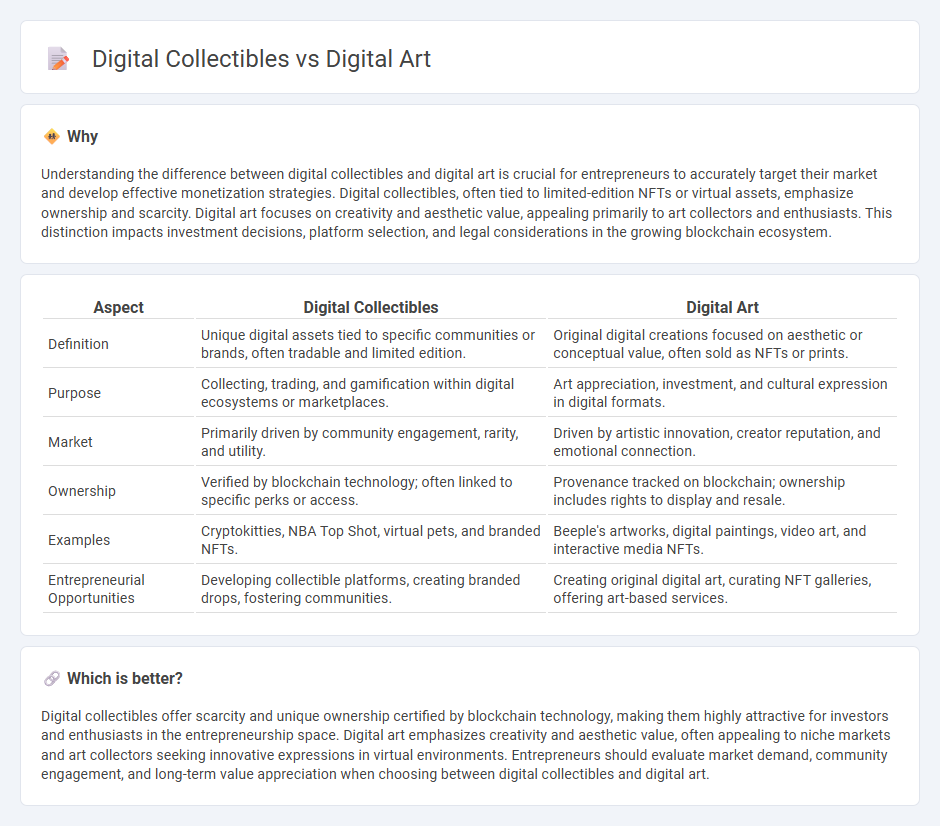
Digital collectibles represent unique, tradable assets often tied to blockchain technology, while digital art encompasses creative visual works shared and sold online. Both sectors leverage NFTs to ensure authenticity and ownership, transforming how creators and collectors engage with digital content. Explore the evolving landscape of entrepreneurship within digital collectibles and digital art to understand emerging opportunities and market trends.
Why it is important
Understanding the difference between digital collectibles and digital art is crucial for entrepreneurs to accurately target their market and develop effective monetization strategies. Digital collectibles, often tied to limited-edition NFTs or virtual assets, emphasize ownership and scarcity. Digital art focuses on creativity and aesthetic value, appealing primarily to art collectors and enthusiasts. This distinction impacts investment decisions, platform selection, and legal considerations in the growing blockchain ecosystem.
Comparison Table
| Aspect | Digital Collectibles | Digital Art |
|---|---|---|
| Definition | Unique digital assets tied to specific communities or brands, often tradable and limited edition. | Original digital creations focused on aesthetic or conceptual value, often sold as NFTs or prints. |
| Purpose | Collecting, trading, and gamification within digital ecosystems or marketplaces. | Art appreciation, investment, and cultural expression in digital formats. |
| Market | Primarily driven by community engagement, rarity, and utility. | Driven by artistic innovation, creator reputation, and emotional connection. |
| Ownership | Verified by blockchain technology; often linked to specific perks or access. | Provenance tracked on blockchain; ownership includes rights to display and resale. |
| Examples | Cryptokitties, NBA Top Shot, virtual pets, and branded NFTs. | Beeple's artworks, digital paintings, video art, and interactive media NFTs. |
| Entrepreneurial Opportunities | Developing collectible platforms, creating branded drops, fostering communities. | Creating original digital art, curating NFT galleries, offering art-based services. |
Which is better?
Digital collectibles offer scarcity and unique ownership certified by blockchain technology, making them highly attractive for investors and enthusiasts in the entrepreneurship space. Digital art emphasizes creativity and aesthetic value, often appealing to niche markets and art collectors seeking innovative expressions in virtual environments. Entrepreneurs should evaluate market demand, community engagement, and long-term value appreciation when choosing between digital collectibles and digital art.
Connection
Digital collectibles and digital art are closely connected through blockchain technology, which ensures authenticity and ownership of unique digital assets. Entrepreneurs leverage this intersection to create innovative marketplaces and monetization channels, driving growth in the digital economy. The rise of NFTs (non-fungible tokens) exemplifies how digital art transforms into valuable collectibles, expanding opportunities for creators and investors.
Key Terms
Ownership
Digital art ownership is defined by unique, often non-fungible tokens (NFTs) that provide verifiable provenance and exclusivity to the holder. Digital collectibles, while also leveraging blockchain technology, emphasize limited-edition or series-based ownership, allowing users to collect, trade, and showcase items with certified authenticity. Explore further to understand how these ownership models impact value and user engagement in the digital realm.
Authenticity
Digital art relies heavily on blockchain technology to verify ownership and establish provenance, ensuring each piece's authenticity through unique cryptographic signatures. Digital collectibles, often found in the form of NFTs, emphasize rarity and possession, with authenticity guaranteed by their immutable digital records. Explore the distinct ways these technologies safeguard value and authenticity in digital creative markets.
Utility
Digital art primarily serves as a creative expression and aesthetic asset, often valued for its uniqueness and artistic appeal, whereas digital collectibles emphasize utility by offering interactive features, gamification elements, or functional uses within virtual ecosystems. NFTs representing digital collectibles can unlock exclusive access, rewards, or governance rights, enhancing user engagement and real-world value beyond mere visual appreciation. Explore how utility-driven digital assets redefine ownership and participation in the digital economy.
Source and External Links
What is Digital Art? | Digital Painting & Drawing Guide - Digital art encompasses artworks created or enhanced using digital technology, ranging from drawings and digital paintings to CGI and electronic media, and is considered "real art" requiring creative skill just like traditional art forms.
Digital art - Wikipedia - Digital art refers to artistic work created or presented with digital technology, with origins dating back to the 1960s, including computer-generated and multimedia art that uses digital tools as part of the creative process.
What is digital art and is it right for you? Here's everything ... - Digital art includes digital painting, animation, VR, and NFT-based artworks, with recent innovations involving AI tools and immersive digital experiences that expand creative possibilities and market reach.
 dowidth.com
dowidth.com